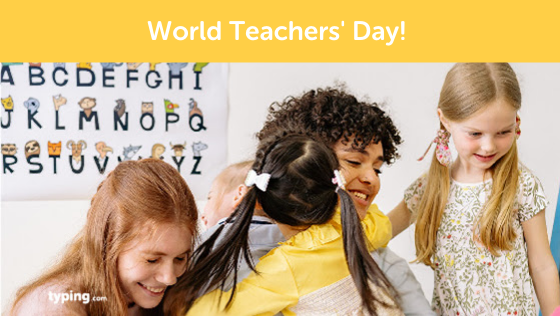Celebrating Teachers With STEM Around the World
By the time a student graduates from high school in the United States, they’ve had nearly 50 different teachers at school. That’s an impressive number of professionals working incredibly hard to make sure that each and every child receives the quality education that they deserve.
From elementary classroom teachers to middle and high school core and elective teachers, these highly qualified educators are shaping the lives of the country’s youngest citizens in innumerable ways.
World Teachers’ Day
That’s why even the smallest gestures of gratitude for teachers are always much appreciated. And what better day to show the teachers in your life just how much you care than on International Teacher’s Day.
International Teacher’s Day, or World Teachers’ Day as it’s also known, was officially designated as an international holiday by Unesco on October 5th, 1994.
The purpose of the holiday is to celebrate all teachers around the world and commemorate the adoption of the Recommendation concerning the Status of Teachers on the same date in 1966 as well as the passing of the Recommendation concerning the Status of Higher-Education Teaching Personnel in 1997.
Generally speaking, these documents set forth the rights and responsibilities of all educators worldwide and the international standards expected of their position.
And many administrators, teachers, staff, students, and parents around see World Teachers’ Day as an opportunity to hand out teacher appreciation day cards and teacher appreciation day gifts to all of the special educators who have changed their lives for the better.
STEM Around the World

Another great way to commemorate this important international holiday is to acknowledge the remarkable work being done by STEM teachers around the world.
The STEM-focused curriculum prepares students to be both critical thinkers and innovators in their fields. And STEM teachers on a global scale get more students excited about and engaged in science, technology, engineering, and mathematics than ever before.
So, we’re going to take a look at how STEM is being taught in different countries around the globe—all thanks to the hard work and dedication of STEM teachers everywhere.
Australia
In Australia, STEM education is guided by the National STEM School Education Strategy published in 2015.
The 2 goals of STEM education in Australia are to:
- Ensure all students finish school with strong foundational knowledge in STEM and related skills
- Ensure that students are inspired to take on more challenging STEM subjects
Plus, there are 5 areas for national action that include:
- Increasing student STEM ability, engagement, participation, and aspiration
- Increasing teacher capacity and STEM teaching quality
- Supporting STEM education opportunities within school systems
- Facilitating effective partnerships with tertiary education providers, businesses, and industries
- Building a strong evidence base
In essence, STEM education in Australia is all about helping students make connections to the real-world applications of studying STEM-related subjects.
Canada
In Canada, STEM education is largely based on the Canada 2067 Learning Roadmap.
This roadmap establishes six learning pillars of STEM education in Canada:
- How we teach
- How we learn
- What we learn
- Who’s involved
- Where education leads
- Equity and inclusivity
And each of these six learning pillars includes its own set of key questions, visions, and recommended goals and targets to hit by 2023. So, it should come as no surprise that Canada is one of the leaders in STEM education around the world.
China
In China, STEM education officially entered the curriculum through the The 13th Fifth Year Plan for Education in the Information Age report.
According to the Ministry of Education, the two of the goals of STEM education in China include:
- Developing core competencies
- Promoting a communicative, collaborative, critical, and innovative “21st-century skillset”
In fact, China has an impressive number of students who go on to earn Ph.Ds in STEM fields each year.
India
In India, STEM education received a big boost in the National Education Policy of 2020.
According to this policy, all students should learn the following STEM-related skills in school:
- Scientific temper and evidence-based thinking
- Problem-solving and logical reasoning
- Digital literacy
- Coding
- Computational thinking
- Environmental awareness
- Sanitation and hygiene
- Artificial Intelligence
- Design Thinking
In India, there is a big push for hands-on and exploratory learning opportunities in all STEM fields.
Ireland
In Ireland, STEM education focuses on the framework set forth by the STEM Education Policy Statement in 2017.
It includes four pillars of policy development and action:
- Nurture learner engagement and participation
- Enhance early years practitioner and teacher capacity
- Support STEM education practice
- Use evidence to support STEM education
In other words, Ireland is very focused on having a digitally savvy and highly skilled workforce to meet the needs of its top employers.
United States
In the United States, STEM education is based on the guidelines set forth by the Charting a Course for Success: America’s Strategy for STEM Education report completed in 2018 by the National Science & Technology Council.
The three goals of STEM education in the United States are to:
- Build strong foundations for STEM literacy
- Increase diversity, equity, and inclusion in STEM
- Prepare the STEM workforce for the future
And the three pathways for accomplishing these goals are to:
- Develop and enrich strategic partnerships
- Engage students where disciplines converge
- Build computational literacy
In summation, the top goals for STEM education in the United States are innovation, opportunity, and diversity.
Celebrating Teachers

As you can see, teachers around the world are all working towards the same goal of providing a quality education to all of their students.
STEM teachers in particular understand just how important the science, technology, engineering, and mathematics disciplines are to the industry leaders that will eventually hire their students.
While countries around the world certainly have different frameworks for reaching their STEM-related goals, each of these countries is making huge strides thanks to the STEM teachers they employ.
So take some time to read some inspirational teacher’s day quotes and say thank you to your favorite teachers on World Teachers’ Day. They will really appreciate it.

